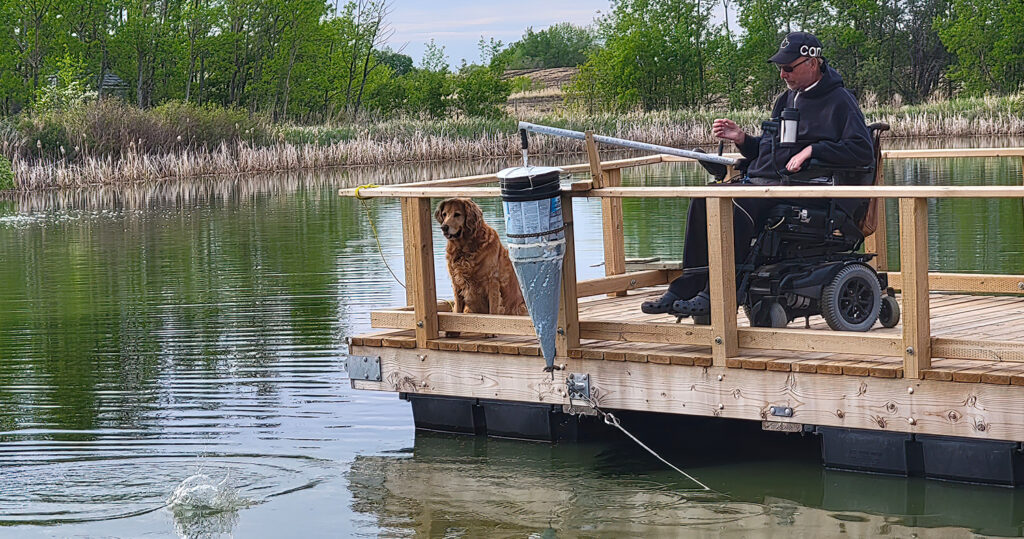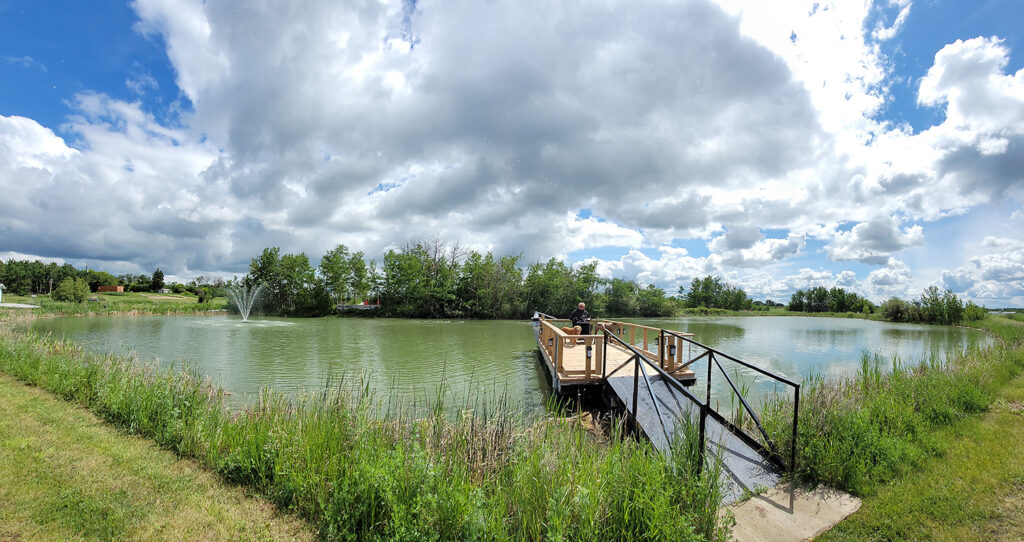
The sun is starting to shine, the phone isn’t ringing yet, and the only sounds I can hear from my pondside dock are the chorus of serenading songbirds and the gentle hum of the aerator in the background. It’s a beautiful morning and a perfect setting to enjoy my coffee with the dogs.
I lift the handle on my custom feeder, and a handful of fish-food pellets drop into the pond. They start spreading out and slowly make their way across the water, using the breeze and the current as propulsion. I sip my coffee while the dogs hang over the edge of the dock, peering into the water, waiting for the action to begin.
After a few minutes of quiet contemplation, I’m rewarded as a two-pound rainbow trout erupts from the water, attacking the food. The splash echoes across the pond, signaling other trout to join the frenzy. Soon the surface of the water is alive with jumping fish.
I feel lucky to be able to start the day like this. I’m able to do so because about 30 years ago my friends and I had a vision and the follow-through to bring it to life.
From Pondering to a Pond
I’ve loved fly-fishing since I was a kid. My family took yearly excursions to the mountains where we spent a couple of weeks fly-fishing for trout. I looked forward to these trips all year. After school I often set up my fly rod and practiced casting. With ice cream pails on the lawn as targets, I’d try to land a small split shot weight into them. Soon I could drop a fly any place I wanted — a valuable skill for landing wary fish.
“There were a few minor obstacles. We had no equipment or water, and we lacked knowledge of raising fish. On the plus side, we had enthusiasm and lots of room.”
After my car accident, I returned home to my parents’ farm and tried to adjust to life as a quadriplegic. A friend rigged a rod and reel, and I got back to practicing casting on the lawn. I quickly convinced myself that casting a fly rod was possible. There was only one problem: There were no lakes nearby that were accessible from a power wheelchair.
The solution to this problem started like so many other brilliant ideas — as beer talk among friends. If there were no accessible lakes nearby, we’d just make one. Problem solved.
There were a few minor obstacles. We had no equipment or water, and we lacked knowledge of raising fish. On the plus side, we had enthusiasm and lots of room. We borrowed a university aquaculture book, took a course on building trout ponds, and scrounged together what money we could; my grandparents and parents chipped in, I had a little stash, and we found a government grant. All told, we figured about $5,000 should do it.

We learned what it would take to build a pond where the fish could thrive. The water would need to be at least 15 feet deep for trout to stay within their temperature range. Steep banks would allow fishing all around and prevent overgrowth of weeds, while aeration would keep oxygen levels high throughout the year to ensure the trouts’ survival.
A local man with a bulldozer and scraper surveyed the yard and laid out a plan to dig a large pond and landscape the yard at the same time. He understood that wheelchair accessibility was the primary goal. We shared what we knew about pond design, and he started right away. The pond — a one-acre, 25-foot-deep hole — took about a month to dig. We put a water well in and pumped for about three months to fill the pond over the winter. The next spring some friends brought an accessible dock from their marina.
Initially we had only rainbow trout, and I enjoyed many a fight with a large rainbow on the fly. Our pond is now full of minnows which must’ve been introduced by birds. The rainbow trout don’t appear to eat many of them, so we stocked some brook trout. We are also planning to add some tiger trout, a cross between brown and brook trout. Apparently they are very aggressive, love to eat minnows, grow quickly and are easy to catch.
Trout will grow to 20 pounds or more if fed properly, so I needed a way to supplement their diet with trout food — high-energy pellets that make them grow fast and taste good. Food costs about $75 per five-gallon pail, and we’ll probably feed four pails over the summer.
Aside from the entertaining sight of a quadriplegic aimlessly spraying pellets everywhere but in the pond, throwing them with my quad hands didn’t work so well. The dog was gaining weight much faster than the fish — a new program was in order. Fortunately, my friend Garnet, who can build anything, devised a one-off fish feeder I could operate. It consists of a five-gallon plastic pail with a spring-loaded ski pole down the middle. It is attached with strapping to the side of the dock so the pellets drop in the water. When the handle is lifted, the pole is pushed down, and a hole in the bottom of the pail opens to drop some pellets into the pond.
Even three decades later, spending my morning on the dock has become one of my favorite pastimes. I’ll wheel down, drop some food into the water and enjoy a coffee while watching the trout rise. I love to grow them big and watch them cruise by the dock in search of a meal.
I fly-fish occasionally when the fish are big, but watching them is fun, too. I’m currently in the rebuilding process. A couple of years ago all my fish died when an aerator failed. I upgraded my system, and now I’m enjoying watching the fish grow again. I’ll have eight-plus-pound trout in a year or two, and this time they’ll be safe from low oxygen levels.
My parents and grandparents are long gone now, but every time I see a trout jump, I’m taken back to my childhood. Suddenly I’m a kid, fly-fishing with his family in the mountains, with not a care in the world beyond getting a trout to bite.
Support New MobilityWait! Before you wander off to other parts of the internet, please consider supporting New Mobility. For more than three decades, New Mobility has published groundbreaking content for active wheelchair users. We share practical advice from wheelchair users across the country, review life-changing technology and demand equity in healthcare, travel and all facets of life. But none of this is cheap, easy or profitable. Your support helps us give wheelchair users the resources to build a fulfilling life. |


Okay, call me a fan of Kary Wright. I am. He’s been a friend for many years since we met at South Padre Island TX. I’ve followed he and his lovely wife’s adventures through Facebook and email, texting and his writing. He’s been an inspiration (I’m not a quadriplegic) and a darned good writer (I’m a retired writer…translation: lazy). I enjoyed this article and learned much from it as I have from others he’s written. The most important thing I learned is we can overcome many adversities with determination and faith (except laziness perhaps). Good piece of work Mr Wright! Now about that special bait we use in Oklahoma called dynamite….
Thanks so much Norm! I’m so blessed to have the friends and family (yourself included), that help with all the logistics, ideas, troubleshooting etc that are such a huge part of everything I get to experience!